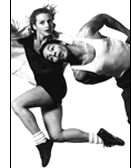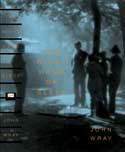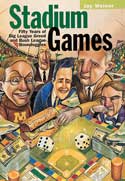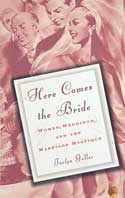

 |
|||
|
Bookshelf
How
can we make peace with the traumas of our past when the future threatens
grimmer days still? That question hovers over the protagonist in
John Wray’s scrupulously crafted debut novel, The Right Hand
of Sleep. In his arrestingly evocative style, Wray creates a complex
portrait of the proverbial “nowhere man,” a shell-shocked
World War I deserter who exiles himself from everything he knows
only to seek it out again at a time when nothing looks familiar. Best
Friends Of particular interest to Oberlin alumni is this first novel by an MD in Dayton, Ohio. Moody centers her story on two unlikely first-year Oberlin roommates in 1973 whose friendship endures through motherhood, disastrous marriages, and demanding careers. Clare, a cynical, hard-working, and jaded mid-western Protestant, is fascinated by Sally’s well-to-do Jewish family in California. Envious of Sally’s perfect family and enigmatic father, Clare is stunned to discover over the years the truth that lurks behind the credible façade. The story explores the shifts in loyalty and perspective that long-term friendships can experience and, nevertheless, survive. Moody, a recent finalist for The Best American Short Stories anthology, is married with four sons. Flux:
Women on Sex, Work, Love, Kids, and Life in a Half-Changed World
This book is essential reading for the married, unmarried, childless, parents, careerists, and stay-at-homes, both men and women. Orenstein spent four years interviewing more than 200 women across the country, both alone and in small groups, to get a sense of the key pressures they endured. Most held college degrees and ranged in age from 25 to 45. She explores the limits women still face and shares the nature of a woman’s dilemma: the competing personal, political, and social forces that demand painful trade-offs. The reader may helplessly identify with some of these women and possibly begin to reevaluate personal lifestyle choices. Orenstein is an award-winning author and speaker on issues affecting girls and women and a contributing writer to The New York Times Magazine, Vogue, Glamour, Mirabella, and The New Yorker. She has also served as editor at Esquire, Mother Jones, and several other contemporary magazines.
A sports reporter with the Minneapolis Star Tribune, the author frequently delivers sports commentary on Minnesota Public Radio. He zooms in on the state’s 50-year history with pro sports and the issues contributing to a bid for the Minnesota Twins new stadium, along the way providing a big-picture evaluation of national sports economics. In an unflinching account full of photographs, stories, scandals, and colorful personalities, Weiner divulges how powerful interests in the Twin Cities employed deceit and thinly veiled threats to push through a publicly funded baseball stadium. This is a lesson in politics and economics by a writer who believes that a city may well need a major league team to be major league, and who offers pragmatic suggestions on how fans can make this all work in their own best interests. At Oberlin, Weiner played for the baseball team and was sports editor for The Oberlin Review. He lives in St. Paul with his wife and two sons. The
Good People of New York “A spirited and accomplished first novel” is a reviewer’s consensus of Nissen’s exploration of an unlikely marriage that takes second place to the couple’s only child. The new mother’s love for their baby daughter skews all other relationships, splits the marriage, and invites the reader to meet a changing cast of well-drawn characters with both unhappy and hilarious results. Nissen’s descriptions of life in New York during the ’70s and ’80s are right on the mark. The reader follows the daughter through her wild and undisciplined teenage escapades as she attempts to become the focus of her own life. Nissen, winner of a short fiction award for Out of the Girls’ Room and into the Night has shifted her focus to the novel. She is a graduate of the Iowa Writer’s Workshop and a former James Michener Fellow. A native New Yorker, Nissen now lives in Iowa.
Is
marriage an institution that young women should want to join? Geller
examines modern marriage using histories of women, histories of
marriage, and popular culture to arrive at the conclusion that marriage
institutionalizes gender inequality. She calls into question some
of the deepest-held beliefs about the tradition, using three sections:
“Courtship and the Marriage Quest,” “The Big Day,”
and “Living in the Plural.” Not everyone will agree that
marriage is profoundly hostile toward women and an empty and unrealistic
dream, but the popular notion that marriage is a woman’s destiny
comes in for careful exploration. The author poses as a bride at
Bloomingdale’s and records the typical bridal registry experience
with deep reservations. This is a book for both the bride-to-be
and women’s studies library collections that may set back the
centuries-long, pro-marriage marketing campaign for nuptial bliss.
Geller teaches English at New York University where she is completing
her PhD. She is not married.
|
|
back to top |
 The
Right Hand of Sleep
The
Right Hand of Sleep Stadium
Games: Fifty Years of Big League Greed and Bush League Boondoggles
Stadium
Games: Fifty Years of Big League Greed and Bush League Boondoggles Here
Comes the Bride: Women, Weddings, and the Marriage Mystique
Here
Comes the Bride: Women, Weddings, and the Marriage Mystique